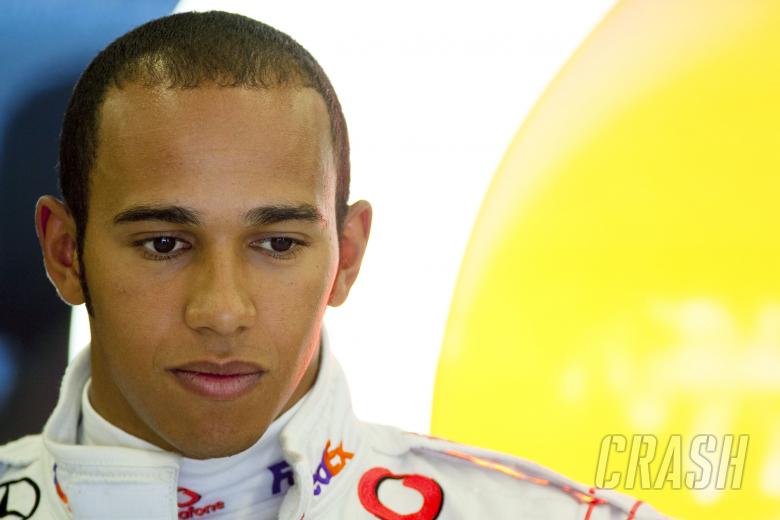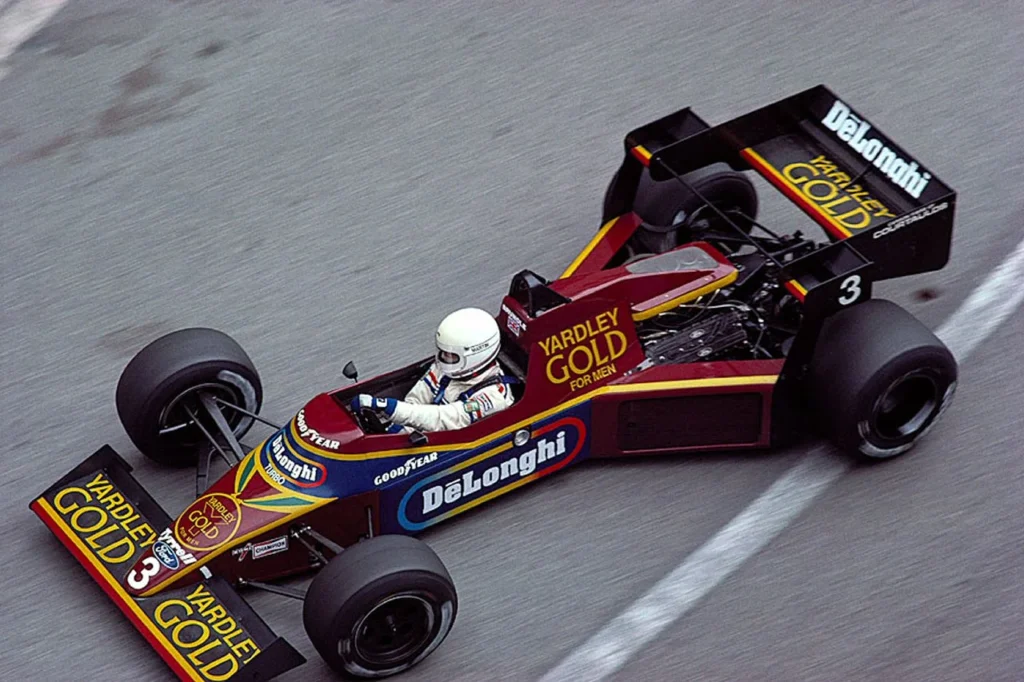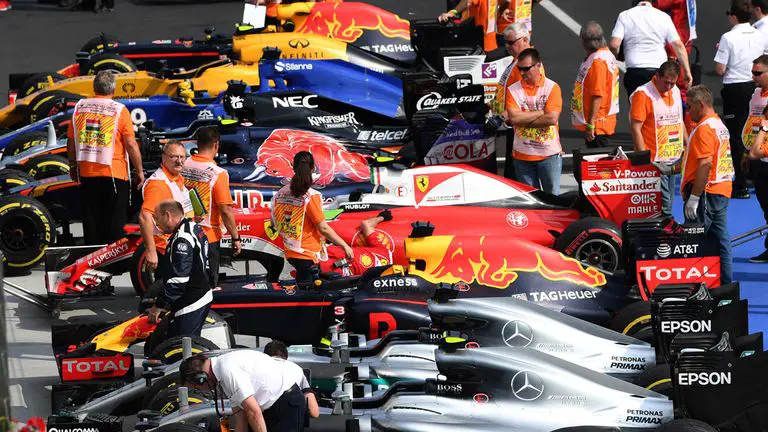Formula 1 is a thrilling and glamorous sport, where the best drivers in the world compete for glory and fame.
But behind the scenes, there is a complex and strict set of rules and regulations that govern every aspect of the sport, from the design of the cars to the conduct of the drivers. And when these rules are broken, the consequences can be severe and costly.
In this article, we will reveal the most expensive penalties in F1 history, and how they affected the teams and drivers involved.
From shocking scandals to controversial incidents, these are the fines that made headlines and shook the foundations of F1. Prepare to be astonished by the staggering amounts of money that were paid or lost as a result of these penalties, and how they changed the course of F1 history.
F1 Penalties – Michael Schumacher [1994] – $25,000
![Michael Schumacher [1994]](https://f1worldwide.com/wp-content/uploads/2023/06/Michael-Schumacher-1994-1024x576.jpeg)
The seven-time world champion was fined $25,000 for ignoring a black flag during the British Grand Prix at Silverstone in 1994.
Schumacher had overtaken Damon Hill on the formation lap and failed to serve a five-second stop-go penalty within the required time. He continued to race until lap 27, when he was disqualified and ordered to stop by the stewards.
Schumacher claimed he did not see the black flag, but the FIA did not accept his excuse and also gave him a two-race ban.
F1 Penalties – James Hunt Was Disqualified
James Hunt was one of the most charismatic and flamboyant drivers in F1 history, known for his wild lifestyle and fierce rivalry with Niki Lauda. He was also a talented and determined racer, who won the 1976 world championship in dramatic fashion.
His title campaign was not without controversy, as he faced several disqualifications and appeals that threatened to derail his chances.
One of the most notorious incidents occurred at the 1976 Indonesian Grand Prix, where Hunt was disqualified after stewards found his McLaren to be too wide at the rear.
Hunt had qualified on pole position for the race, ahead of Lauda and his Ferrari team mate Clay Regazzoni. He made a good start and led the race comfortably, while Lauda struggled with tyre wear and dropped to fifth place.
Hunt seemed to be on course for a dominant victory, which would have given him a crucial advantage over Lauda in the championship standings.
However, Hunt’s car was inspected by the stewards. They measured the width of his rear tires and found them to be 1.5 cm’s wider than the allowed limit of 60 cm’s. The stewards ruled that Hunt had breached the technical regulations and disqualified him from the race, handing the win to Regazzoni and promoting Lauda to second place.
The Driver And Team Were Outraged
Hunt and McLaren were stunned and outraged by the decision. They claimed that they had not cheated or gained any advantage from the wider tires. They argued that the tires had expanded due to the heat and pressure during the race.
The team maintained that they had been within the limit before the start. McLaren also pointed out that they had used the same tires in previous races without any problems. They appealed against the disqualification, hoping to get their victory reinstated.
The Matter Went To Appeal
The appeal was heard by the FIA’s International Court of Appeal in Paris. McLaren showed that their tyres had been measured before the race by Goodyear, the tire supplier, and found to be within the limit.
They also showed that their tires had been checked by scrutineers before qualifying. They claimed that the stewards had used faulty equipment and methods to measure their tires after the race.
The team also questioned the impartiality and competence of the stewards. They had been appointed by the Indonesian Automobile Association rather than by the FIA.
Despite McLaren’s arguments and evidence, the FIA’s Court of Appeal upheld the stewards’ decision. They concluded that Hunt had gained an unfair advantage. The verdict was that the wider tires gave him more grip and stability on the track.
The verdict was a devastating blow for Hunt and McLaren, who lost their 9 points for winning the race. The team and Junt fell behind Lauda in the championship battle.
Hunt was furious and felt cheated by the FIA and the stewards, and accused them of being biased and corrupt. He also blamed Goodyear for supplying him with faulty tires, and threatened to boycott the next race in Japan.
He eventually decided to continue racing, and managed to overcome the setback and win the title by one point over Lauda, after a dramatic finale at Fuji Speedway.
The Indonesian Grand Prix was one of the most controversial episodes in Hunt’s career, and one of the most disputed decisions in F1 history.
Lewis Hamilton Penalty [2009] – $50,000

The six-time world champion was fined $50,000 for misleading the stewards after the Australian Grand Prix in 2009.
Hamilton had finished fourth on the road, but was promoted to third after Jarno Trulli was penalized for passing him under the safety car.
However, it later emerged that Hamilton had deliberately let Trulli pass him on the instruction of his McLaren team, who then lied to the stewards about the incident. Hamilton apologized for his role in the controversy and admitted he was “misled” by his team.
F1 Penalties – Tyrell Was Disqualified And Fined $100,000

Tyrell was one of the most successful and respected teams in F1 history. They won six constructors’ championships and three drivers’ championships between 1971 and 1973.
By the mid-1980s, the team was struggling to keep up with the competition. The turbocharged teams that dominated the sport and Tyrell had stuck with their naturally aspirated engines.
They tried to find other ways to gain an edge over their rivals. One of their innovations was to use water tanks in their cars, which they claimed were for cooling purposes.
However, the FIA suspected that Tyrell was using the water tanks to manipulate the weight of their cars. They launched an investigation that led to their exclusion from the 1984 season.
The controversy began at the 1984 Detroit Grand Prix. Tyrell driver Martin Brundle finished second behind Nelson Piquet’s Brabham.
Tyrell Was Disqualified
After the race, Brundle’s car was found to be underweight when weighed without fuel. The stewards disqualified Brundle from the race, and also impounded both cars for further inspection.
They discovered that Tyrell had installed two water tanks in their cars
- One in the nose
- One in the rear.
The tanks were connected to a valve that allowed the driver to release water onto the track at will.
The stewards concluded that Tyrell had used the water tanks to reduce the weight of their cars during the race. They refilled them before the post-race weigh-in to meet the minimum weight limit of 540 kg.
The stewards also found traces of aromatic hydrocarbons in the water. This suggested that Tyrell had added fuel to the water to increase its density and performance.
The stewards reported their findings to the FIA, who summoned Tyrell to a hearing before the World Motor Sport Council in Paris.
Tyrell Defended Their Design
Tyrell defended their design, and argued that they had not broken any rules or gained any advantage. They claimed that the water tanks were for cooling purposes only. The system released water onto the track to prevent overheating of their brakes and engine.
The team also denied adding any fuel or other substances to the water. They said that the traces of hydrocarbons were due to contamination from the fuel system. They also pointed out that they had used water tanks in previous races without any problems or protests from other teams.
The FIA’s World Motor Sport Council rejected their defense. They ruled that Tyrell had used water tanks to manipulate the weight of their cars during the race. The council also ruled that Tyrell had released water onto the track to improve the grip and handling of their cars.
By doing so, and that they had endangered the safety of other drivers and officials . Tyrell was disqualified from the 1984 season, and stripped of all their points and results. They also fined them $100,000, and ordered them to pay the costs of the investigation and hearing.
The verdict was a harsh and humiliating punishment for Tyrell, who lost their reputation and credibility in F1. Tyrell were forced to withdraw from F1, and missed the last three races of the season.
They returned in 1985, but never recovered from the scandal, and eventually sold their team in 1998.
F1 Penalties – Ferrari [2010] – $100,000
![f1 penalties - Ferrari [2010]](https://f1worldwide.com/wp-content/uploads/2023/06/Ferrari-2010.webp)
Ferrari were given a sizeable fine after blatantly imposing team orders on Felipe Massa to give victory to Fernando Alonso and affecting the outcome of the 2010 German Grand Prix.
A year to the day after his traumatic accident in Budapest in 2009, Felipe Massa had been leading the race at Hockenheim. His race engineer Rob Smedley got on team radio and said “Felipe, Fernando is faster than you. Do you understand?”
Massa yielded position to Alonso behind him. Team orders, then illegal, resulted in Ferrari being given a $100,000 fine.
This was “small potatoes” for Ferrari as the extra points kept Alonso’s title challenge burning.
The stewards forwarded the case to the World Motor Sport Council, who upheld the stewards’ decision but opted against any further sanctions against Ferrari.
Ferrari’s actions resulted in the team orders rules being adjudged as untenable, with team orders legalized for 2011 as a result.
F1 Penalties – USF1 [2010] – €309,000 ($326,000)

USF1 were a short-lived American-led attempt at a Formula 1 team, headed up by Ken Anderson and Peter Windsor.
Granted entry for the 2010 F1 World Championship, USF1 ultimately failed to enter and were investigated for breaching the Sporting Regulations and the International Sporting Code as a result. The team went into liquidation before even entering a race.
The FIA became a creditor after imposing a fine of €309,000. This was equivalent to the entry fees for the 2010 Championship.
USF1 were also excluded from ‘any competition’ as a result of the FIA investigation.
The fine served as an effective forfeiture of the entry fee, while the team were also ordered to pay the FIA’s costs for the disciplinary procedure.
The team had attempted to argue force majeure as a reason for their lack of finances, citing negative media coverage (which included a statement of doubt from then F1 boss Bernie Ecclestone), but the FIA ruled there was no evidence for this.
F1 Penalties – Racing Point [2020] – €400,000 ($473,000)
![Racing Point [2020] - €400,000](https://f1worldwide.com/wp-content/uploads/2023/06/Racing-Point-2020-E400000.webp)
The team that evolved into the current Aston Martin squad were hit with a 400,000 euro fine during the 2020 season.
Fellow midfielders Renault protested against the design of Racing Point’s front brake ducts. The protest started after the Styrian Grand Prix. The FIA seizing the car’s brake ducts for a closer look.
Renault complained about the design being strikingly similar to that of Mercedes’ 2019 design for their title-winning W10. The FIA ruled that Racing Point had breached the sporting regulations by not designing their own brake ducts. It also ruled that they had not broken the technical rules as the parts were legal and within the specifications.
Racing Point were fined 200,000 euros for each car and also docked 15 constructors’ championship points. The team appealed the decision, but later withdrew it after reaching an agreement with the FIA and the other teams.
The case also prompted a clarification of the rules on copying for 2021, with stricter limits on what teams can share and replicate.
F1 Penalties – BAR Honda [2005] – $2 million
![BAR Honda [2005] - $2 million](https://f1worldwide.com/wp-content/uploads/2023/06/BAR-Honda-2005-2-million.jpg)
BAR Honda were slapped with a $2 million fine and banned from two races. This happened after ir was found guilty of running an illegal car at the 2005 San Marino Grand Prix.
The team had finished second and third with Jenson Button and Takuma Sato. When they were tested the cars were found to be underweight when drained of fuel during post-race scrutineering.
The FIA accused BAR of using a hidden secondary fuel tank to circumvent the minimum weight limit of 605kg.
BAR claimed they had not broken any rules and that the secondary tank was part of the fuel system design. The FIA’s International Court of Appeal upheld the stewards’ decision to disqualify BAR from the race.
It also agreed to ban them from the next two rounds in Spain and Monaco. On top of this it imposed a $2 million fine and a six-month suspended ban. BAR accepted the verdict and apologized for their mistake, while also vowing to improve their communication with the FIA in the future.
F1 Penalties – McLaren [2007] – $100 million
McLaren were hit with a record-breaking $100 million fine and excluded from the 2007 constructors’ championship after being found guilty of possessing confidential information belonging to Ferrari.
The scandal, known as ‘Spygate’, erupted when Ferrari accused McLaren’s chief designer Mike Coughlan of having access to a 780-page dossier of Ferrari technical data. This was obtained from Nigel Stepney, a disgruntled former Ferrari employee.
The FIA launched an investigation and found damning evidence. McLaren drivers and engineers had been aware of and used the Ferrari information to their advantage.
The World Motor Sport Council ruled that McLaren had breached Article 151c of the International Sporting Code. This prohibits any fraudulent conduct or act prejudicial to the interests of any competition.
McLaren were fined $100 million. This was later reduced to $50 million after excluding the team’s share of TV revenue. It was also stripped of all their constructors’ points for 2007.
Their drivers Lewis Hamilton and Fernando Alonso were allowed to keep their drivers’ points and continue to fight for the title, which they both narrowly lost to Ferrari’s Kimi Raikkonen by one point.
Read More About The Story Here
F1 Penalties – Renault [2008] – Disqualification
![Renault [2008] - Disqualification](https://f1worldwide.com/wp-content/uploads/2023/06/Renault-2008-Disqualification.jpeg)
Renault were disqualified from the 2008 season and given a suspended permanent ban.
They were found guilty of orchestrating a deliberate crash at the Singapore Grand Prix that year. The incident involved Renault driver Nelson Piquet Jr crashing his car on lap 14. This triggered a safety car period that benefited his team mate Fernando Alonso, who had pitted early.
Alonso Went On To Win The Race
The FIA launched an investigation after Piquet Jr made a confession. He admitted that he had been ordered by Renault team principal Flavio Briatore and engineering director Pat Symonds to crash on purpose.
The World Motor Sport Council ruled that Renault had conspired to cause an intentional accident. This had endangered the lives of spectators, officials, other competitors and Piquet Jr himself.
Renault were disqualified from the 2008 championship and given a permanent ban from F1. The permanent ban was suspended for two years on condition that they committed no further breach.
Briatore was banned from any involvement in F1 for life, while Symonds was banned for five years.
Both bans were later overturned by a French court, but Briatore agreed not to work in F1 until 2013. Symonds joined Williams in 2013 as chief technical officer.
Read more about the story here
Mercedes [2013] – Reprimand
Mercedes were reprimanded and banned from participating in the young driver test in 2013. This happened after they were found guilty of conducting an illegal tire test with Pirelli.
The incident took lace at the Spanish Grand Prix that year.
Mercedes had used their current car and drivers Lewis Hamilton and Nico Rosberg to test Pirelli tires. The test lasted for three days at Barcelona and they did not inform or invite the other teams or the FIA.
It was deemed to be in breach of the sporting regulations. These prohibit in-season testing with current cars or drivers.
Mercedes argued that they had received permission from Pirelli and the FIA’s former technical delegate Charlie Whiting.
The FIA’s International Tribunal rejected their defense and issued a reprimand and a ban from the young driver test as a sanction. Mercedes accepted the verdict and apologized for their error of judgement.
Read More About the story here
Ferrari

The suspicion over Ferrari’s engine started in 2019, when several teams noticed that Ferrari had made a huge leap in performance after the summer break. Ferrari won three races in a row and challenged Mercedes for pole positions and victories.
Some teams suspected that Ferrari was using a clever trick to bypass the fuel flow meter. This device measures how much fuel the pump injects into the engine. It limits it to 100 kg/hour.
There was lots of intrigue ending with the FIA arriving at a confidential agreement with Ferrari. The final penalty was never publicly stated .
However Ferrari suffered a dramatic loss of performance and competitiveness in 2020, finishing sixth in the constructors’ championship. They failed to win a single race for the first time since 2016.
Its customer teams Alfa Romeo and Haas also struggled at the back of the grid. Many observers attributed Ferrari’s decline to its engine woes and speculated that Ferrari had indeed cheated in 2019.

